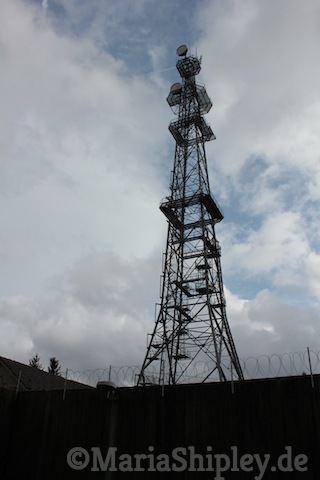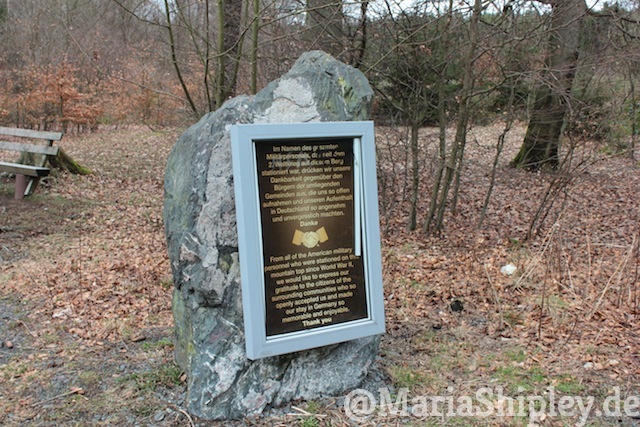This afternoon, we drove for about 20 minuten to the Kolbenberg Mountain, which is part of the Taunus Mountain region and the Taunus Nature Park. It borders the towns of Oberursel to the southeast, Schmitten to the northwest, and Bad Homburg to the southeast.

Radio Relay Site Kolbenberg, Germany
The Kolbenberg is about 690m in height, compared to the Feldberg with 890m.
The reason for this trip was one of my blog readers, who had the following question: Could you tell me the name of the of the small U.S. Air Force station above Camp King. We would go up there to their enlisted club to watch the American (military) TV channel that we didn’t have on Camp King. I remember a few soldiers talking about using the Air Force station to call home using their radio system.
On the summit of the Kolbenberg, there is a large telecommunication system with a visible lattice mast, which was used by the U.S. Air Force until 2007. Since the withdrawal of the U.S. military, the mast has been used by civilian radio services, including mobile radio.

Barbwire around the Kolbenberg Radio Relay Site
Far into the 1950s, there was also a ground radar station for the MGM-1 Matador (Matador Missile), which was a radio-controlled cruise missile stationed in West Germany during the Cold War. In the event of a launch, the missile was remote-controlled by ground-mounted radar stations, such as the one on the Kolbenberg.
The plant was rebuilt and expanded over the years. In 1962, the lattice mast was finished. At first it was painted red and white. The lattice mast is about 100 m high and can be seen clearly from far away. Since that time, the system was only used as a radio relay site. At peak times, 20 to 25 antennas were mounted on the lattice mast, often called “dishes” by the American soldiers because they looked like soup bowls.
From the station, signals were sent northwards to Obernkirchen / Schwarzenborn, east to the Wasserkuppe and southeast to Breitsol / Geiersberg. To the southwest, signals were sent to Wiesbaden, to the north-east in the direction of Stein. Those for Rhine-Main Airbase and Darmstadt were sent to the south. Towards the west, Donnersberg was signalled.
The plant was officially called the “Feldberg Radio Relay Site”. This often caused confusion because there was also a broadcasting system in the Black Forest on the Feldberg. In the local vernacular, the station is also called “Sandplacken” or “Kolbenberg”.
In the 1960s, a part of today’s existing station was enclosed by a simple wood fence. At that time about 20 employees of the U.S. Air Force were stationed there. Most of them worked in the “Telephone Switching Center”. In 1969, up to 150 personnel were on the ground, among them communication personnel, four cooks in the canteen, as well as five in the administrative section. The personnel lived in specially built barracks directly on the premises. At the beginning of the 1970s, soldiers set up a small club with a mini-cinema on the ground floor of the barracks. At the same time, the wooden fence was replaced by a wire one.

Guard-house at the Kolbenberg Site, Germany
In the mid-1980s, terrorist threat in Germany from groups like the Red Army Faction (RAF) rose sharply. As the largest radio relay site in Europe was located on the Kolbenberg, a wall about 5 m high was built around the station. The barrier did not allow any view into the station’s interior, and the access through the walls were built so that in the event of a breakthrough with vehicles, the station could not be damaged. At this time, the barracks on the site had to be given up, probably because of space limitations. The soldiers then resided at Camp King in Oberursel.

Kolbenberg
The last employee of the U.S. Air Force left the station in 1993. From then on, it ran self-sufficiently and was remote-controlled by the Rhein-Main Airbase. Maintenance work and monitoring took place at regular intervals. On the Kolbenberg, there were never any underground facilities or bunkers. This was often claimed because of a translation error on a site map published on different pages and forums in the Internet. Only the water tank was covered with grass.
Since 2007, a telecommunications service company has rented parts of the plant and installed antennas on the grating mast, connected to a separate cable line. Various cable thieves and vandals have already discovered the premises and left visible traces. The current owner is unknown.
The US soldiers stationed on Kolbenberg (at times, up to 150 soldiers) were popular among the locals. They also gave their technical support in the construction of a number of facilities in the neighboring towns. For example, they helped build the bobsleigh track in Oberreifenberg, the Schutzhütte (mountain hut) called Kittelhütte (same name as the mountain pass), and the sports field in Niederreifenberg.
After the withdrawal of the U.S. troops, a memorial stone with a copper plate was erected about 200 meters west of the Kastell Old Hunting House near the Sandplacken mountain pass, with which the US soldiers express their gratitude.
The memorial plaque was stolen in August 2011. Thanks to the sponsoring by a local company, a new one was added in March 2012.

The memorial reads:
From all of the American military personnel who were stationed on this mountain top since World War II, we would like to express our gratitude to the citizens of the surrounding communities who so openly accepted us and made our stay in Germany so memorable and enjoyable. Thank you.




Quite accurate description of the history of Feldberg. I was stationed there with the U.S. Air Force from April 1979 – April 1981. The German telephone company (DBP) referred to us as “Schmitten”. In 1980, those of us who lived in the barracks at the site moved to Rhein-Main Air Base while the barracks was remodeled. The barracks housed up to about 80 men initially; after remodeling it also housed up to 16 female personnel. There were usually about 30-40 of us living in the barracks, everyone else lived either at Camp King or in the nearby towns. There were about 100 personnel stationed there during my time there.
Nice article. I was stationed south of Breitsol at Schwanberg and we took care of that site as well as Brandhoff, Heidenheim and Zugspitze. Was a great time in my career .
I was stationed TDY at Breitsol from the 123rd Sig Bat, 3ID HQ, in 1969. I was there when we walked on the moon.
Nice. I was there March 63 to March 65. My fondest memory was when the Army would have maneuvers in the nearby woods, we would let them borrow our 16mm feature length movies (2 – 4 reels). In return they invited us for their stake cook-out. Also, they gave us a crate of eggs or a 5 gallon box of milk and other goodies. Also, one Saturday morning, a bird Colonel came to the site to ask about the possibility of them being able to get water from the site during their field maneuvers. What impressed me most was his demeanor to me, a A1C, (E3). This man was so sharp in his freshly starched fatigues, obviously having broken starch just before arriving at out gate. I remembered him for the rest of my career, and tried to emulate his military appearance and bearing. (You never know who’s watching’) Thanks for bringing back great memories. Gary Lane, MSgt USAF, Retired.
Glad to hear you have fond memories of your time spent here.
I was there 1973-74 and it was a beautiful forest surrounding a small communication site. Walked the hiking paths every chance I could. While advanced for the time the analog nature of 1970’s communication was primitive as compared to today.
I had the good fortune to be stationed there 1975-1978 with the Air Force. To this day I still value the friendships and great memories of that time. Those memories include many fine people, German and American, as well as walking miles of the Roman Limes, a lot of good food and good bier!
I was at Feldberg from Sept 1968 to December 1969. I loved it there the people were very good to us Airmen. I was on duty in Tech Control when they landed on the moon we had a small TV one of the guys brought in to watch the landing.
Camp King is where I learned you do not call a Army Sergeant Major Sarg. We never wore our ball caps when on the hill and I would go down to Camp King and forget my Ball cap and the Sergeant Major would catch me and make me buy a new one. By the time I left I had a lot invested in ball caps.
After I left Feldberg I went to Clark AFB in the PI it was quite an adjustment.
I was stationed there from Aug 1966 to Aug 1968 as a Tech Controller. While I was there we all lived on the economy. As a single Airman I loved it as I stayed in a Gasthaus in Oberreifenberg and asked the owner to teach me how to speak German and he was gracious enough to sit down with me in his family section of his business and took the time to teach me.After getting transferred I went to a mountain top in Turkey and the difference was amazing.
I was stationed there from Nov. ’65 to Nov. ’68 as an electronic tech. I remember you Chet. You were from Findlay, Ohio. I lived in Smitten, mostly, and learned to play soccer there. They even wanted me to play on the town team. Too bad I was soon to be discharged. I also played chess for Schachverein Oberursel. I learned German there but mostly by living like the Germans except when in uniform. I still have hopes of returning for a visit someday.
John, I remember you from there. When I left there I went to another mountain top in Turkey for a remote assignment. Left there in Aug of 69 and left the Air Force. I have been back to Germany twice while in the Reserve and was at Rhein Main before they closed it and had a chance to drive back up to the
site and it was a lot different after they added the Autovon buildings. From the pictures I see now it’s a
shame that they didn’t just tear it down instead of letting it go into disrepair. I retired in 2007 frpm the
Reserve and live in Georgia now.
I was stationed there May 87 – May 91. The Barracks were knocked down after a fire in the kitchen not long after I left. It is so sad seeing photos of the place I called home for 4-years, like seeing your family home abandoned & decaying. I remember walking past that guard shack every day in and out of the site. I remember protestors at the fence, shouting and shaking fists at us. As NCOD of the facility on my shift, our orders from the site commander were clear. Should anyone climb over that fence, shoot. Our armory had 160 M16s to defend the site (the response time for backup from Camp King was 2-hours) & we conducted frequent security sweeps daily. There were far more good times than bad though. I remember pot-lucks, Christmas parties, & birthdays in the basement of the barracks where the “club” was located. In 1990, we had a joint US-German defense exercise & I got to spend a week with the German Army. It was a great learning experience & I got to meet some great people! I served as the NBC training NCO and maintained the sites NBC defensive equipment. I also was appointed Site Defense NCO and conducted simulated raids to help our security teams deal with the intricacies of the site & surrounding area. The comradery was great and I really missed it near the end. I was there when the automated the site down to Rhein Main and I was one of the skeleton crew left “just in case” something went wrong. My last few months there were 6-hour shifts of 3-on, 3-off, sitting there the whole time reading as there was nothing to do. When I got there in 87, our shift manning had 5-7 people in Tech Control, 3-4 in the AUTOVON switch, and 3-4 in Wideband. When I left, we had 1 in Tech Control, 2 in AUTOVON, & 1 in Wideband. Sometimes, new technology stinks.
I was stationed there from Feb, 1969 through May, 1972. 1945 Comm Sq, Det 12. Feldberg. I was a Tech Controller. We had some radioes known as “PPM” (Pulse Position Modulation) 23 voice channels with swastikas on them. When I arrived there was no officer. Msgt Brown was in charge of Tech Control. I remember Rich Berry. I think I may have a picture of him leaving in his Dress Blues. And John MeDermott is also familiar. I stayed in the “ForestHaus” hotel until moving into the upstairs of a private home in Arnoldshain. Later moved to NeiderReifenburg until the barracks was built. In 1970 or ’71 they installed the AUTOVON switch. As I recall we had one pistol to defend the site and it was assigned to the lead guy in Radio Maintenance.
I was a Tech Controller at Feldberg from Jan., 1966 to July, 1969, and again from Jan, 1973 to July, 1978. When I first arrived in 1966, they were just laying the foundation for the AUTOVON switch addition to the building. They activated the switch about three days before I left in 1969. When I arrived in 1969 there were about 5 or 6 Tech Controllers in the section. When I left in 1978, there were about 40 some Tech Controllers. In 1975, Vicki Comerford, Tech Control, and Susan Howard, Switch Maint, were the first two women assigned to the site. Susan lived in the barracks in the barracks chief’s room so she could have her own latrine and shower. I presently have a web site for Feldberg with over 3,000 pictures. If you are interested write me at bdengel@msn.com
http://www.pension-sprachschule.de/feldberg-radio-relay/reflections-of-my-service-at-u-s-air-force-radio-relay-site-on-the-feldberg-germany/
This is the same place. I was Tech Control there from Feb, 1969 through May, 1972.
If interested write me at LarryTisch4@gmail.com
My last assignment in Germany before leaving the 435th SPS from 1983-1987. Rhein Main Air Force Base, I was the site security supervisor from 1986-1987 for the USAF 1945th Feldberg Communications Site.